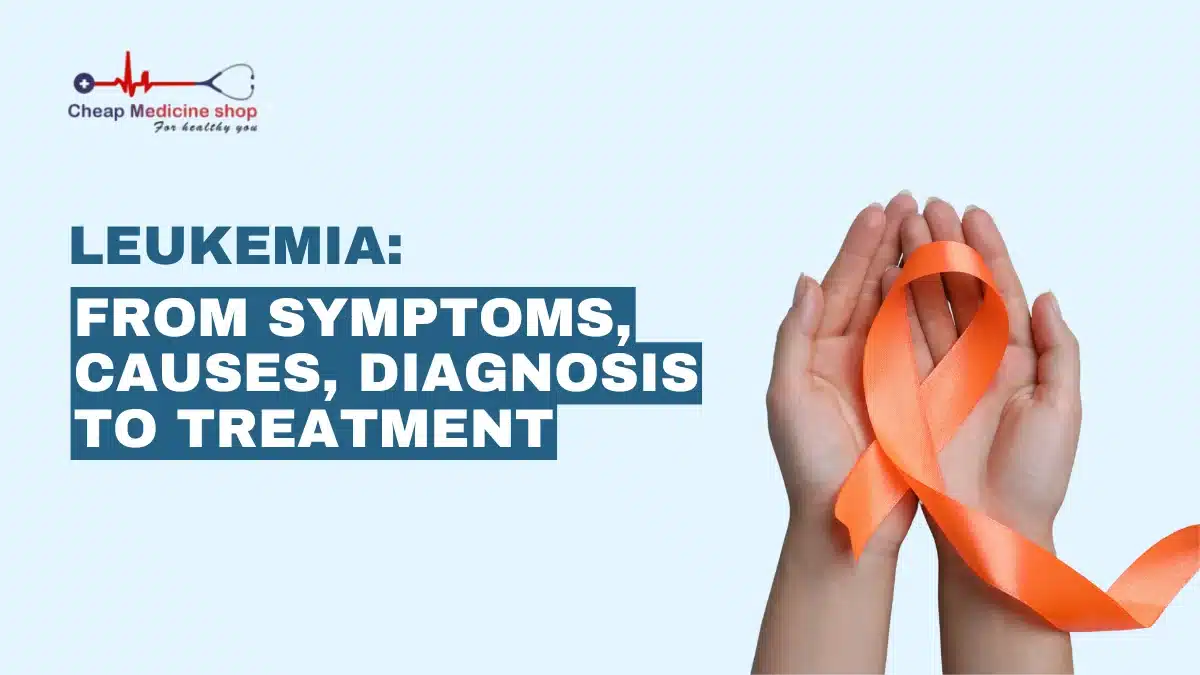Cancer is a broad group of diseases that has affected the lives of millions of people worldwide, characterized by the rapid and uncontrolled growth of abnormal cells. When these abnormal cells originate in the blood-forming tissues, such as the bone marrow, the condition is known as Blood Cancer, such as Leukemia.
Leukemia is a major type of Blood Cancer that specifically affects the White Blood Cells (WBCs), which are crucial for the immune system. In this, the bone marrow produces excessive abnormal WBCs that do not function properly, crowding out healthy blood cells and impairing the body’s ability to fight infections, carry oxygen, and control bleeding.
This Blood Cancer can develop rapidly or slowly, depending on the subtype, and affects people of all ages. It is one of the most common Blood Cancers worldwide, with thousands of new cases diagnosed annually.
This article elaborates on what Leukemia is, its classification, types, symptoms, causes, diagnosis, treatment, prognosis, and more.
What is Leukemia, and how common is it?
It is a type of Cancer, originating in the bone marrow, a spongy tissue inside bones that produces blood cells. It begins when abnormal blood cells, called Leukemia cells (LCs), multiply uncontrollably, crowding out normal blood cells such as Red Blood Cells (RBCs), WBCs, and platelets.
This imbalance, caused by changes in normal blood cells, disrupts the body’s ability to fight infections, carry oxygen, and control bleeding.
It can affect people of all ages, but is found more prevalent in older adults. According to GLOBOCAN, it was the 11th leading cause of Cancer death in 2018. Furthermore, nearly 2.43 million people have this Blood Cancer worldwide.
Save up to 90% on your medicine bills

Abraxane 100 Mg Injection

Alphalan 5 Mg Tablets

Adriamycin 50 Mg Injection

Abirapro 250 Mg Tablet
Classification
Based on the speed of progression and types of cells involved in this Blood Cancer, it is classified into the following types:
Speed of progression
Depending on the speed of progression, it is classified into two types:
- Acute Leukemia (AL): This type occurs when immature blood cells that cannot function normally divide rapidly. As a result, this Blood Cancer develops aggressively and worsens quickly.
- Chronic Leukemia (CL): Unlike its acute form, it involves mature cells that accumulate slowly and function normally. Some produce no early signs of the disease and can go unnoticed for many years.
Type of cells
Depending on the types of affected cells, it is classified into two other types:
- Lymphocytic Leukemia: In this type, the Lymphoid cells that make up the immune system are affected.
- Myelogenous Leukemia: This type develops when normal Myeloid cells develop into RBCs, WBCs, and platelets.
Major types of Leukemia
The following are the main types of Leukemia based on the above classification:
- Acute Lymphocytic Leukemia (ALL): It is the most common in children but can also occur in adults.
- Acute Myeloid Leukemia (AML): Acute Myeloid Leukemia is the second most common type of this Blood Cancer in children and one of the most common types in adults.
- Chronic Lymphocytic Leukemia (CLL): It is another common type of this Blood Cancer in adult. Many people with CLL may not experience symptoms for years.
- Chronic Myeloid Leukemia (CML): Chronic Myeloid Leukemia or Chronic Myelogenous Leukemia develops slowly from Myeloid cells and may go undetected for months or years. It primarily affects adults and can progress to a more aggressive phase if untreated.
Other rare types include Chronic Myelomonocytic Leukemia (CMML), Hairy Cell Leukemia, Myelodysplastic Syndromes, and Myeloproliferative Disorders.
White blood cells (WBCs): These are infection-fighting cells.
Platelets: These form blood clots and stop bleeding.
Leukemia symptoms
The signs of Leukemia depend heavily on the type of Blood Cancer you have. For example, if you have AL, you may experience different symptoms than CL, which you may overlook in the early stages of this Blood Cancer.
Some common signs and symptoms of Leukemia are as follows:
- Fever or chills
- Frequent infections
- Unexplained weight loss
- Fatigue or getting tired easily
- Bone/joint pain or tenderness
- Swollen lymph nodes in the stomach, groin, and neck
- Enlarged liver or spleen
- Leukemia rash (tiny red spots on the skin)
- Bruising or easy bleeding
Leukemia causes and how it develops
The exact cause of Leukemia has yet to be identified. However, it develops due to genetic mutations in blood-forming cells in the bone marrow. This Blood Cancer occurs when a mutation causes one of these developing cells to multiply abnormally, creating LCs that crowd out healthy blood cells. However, the cause of these cells’ mutation has not been identified.
Risk factors
While it can affect anyone, some people are at a higher risk of developing it, such as:
- Age: It is more common in older adults, but some types, like ALL, are more common in children.
- Gender: Assigned Male at Birth (AMAB) individuals are more likely to develop this condition than people of other sexes.
- Genetic predisposition: Family history or genetic disorders such as Down Syndrome, Klinefelter Syndrome, or other conditions.
- Exposure to radiation or chemicals: If you get exposed to radiation, or chemicals, or have had previous Cancer treatment, such as Chemotherapy, you are at a higher risk of developing this blood condition.
- Smoking: Smoking increases the risk of developing AML. Therefore, people who smoke or are around second-hand smoke can develop this condition.
Complications
Like other medical conditions, if left untreated, it can lead to severe complications, including:
- Severe infections are due to a low count of infection-fighting antibodies.
- Anemia is caused by low RBC, leading to fatigue and shortness of breath.
- Bleeding problems due to low platelet counts.
- Spread of LCs to other organs, including the brain and spinal cord.
- Development of a more aggressive form of Cancer, called Diffuse Large B-cell Lymphoma, or Richter’s Syndrome.
Diagnosis and tests
Diagnosis begins with a physical exam and detailed medical history. The following are the major Leukemia diagnoses:
- Physical exam: In this test, your doctor checks your symptoms, such as bruises and bleeding gums.
- Complete Blood Count (CBC): Your doctor will examine different types of blood cells, their number, and maturity. With this condition, you will have a higher WBC count than normal and lower RBC and platelet counts.
- Blood smear: Your doctor will also perform other blood tests, such as cytometry and blood smears, to look at the shape, number, and characteristics of blood cells.
- Bone marrow biopsy: Your doctor will prescribe medication to numb your body and take a small marrow sample from your hip bone. The test will show how many cells are immature and how they are changing.
- Spinal tap: Your doctor will take your spinal fluid sample to check if the condition has affected it.
- Imaging tests: Your doctor can also perform other imaging tests, such as CT scans, X-rays, and an MRI, to check for organ enlargement.
- Genetic and molecular tests: This test will identify specific mutations for effective treatment.
Leukemia treatment
Treatment depends on its type, age, and overall health. Common treatments include:
- Chemotherapy: It is the primary treatment for most Leukemias. It involves using medicines that kill rapidly dividing LCs throughout the body. Chemotherapy can be received orally, intravenously, or directly into the cerebrospinal fluid to target brain and spinal cord LCs.
- Targeted therapy: It uses medications designed to attack specific genetic mutations or proteins found in LCs.
- Radiation therapy: It employs high-energy X-rays or beams to destroy LCs or shrink enlarged organs like the spleen or lymph nodes.
- Stem cell transplant: This procedure replaces diseased bone marrow with healthy stem cells. Before the transplant, high doses of Chemotherapy and/or radiation are given to eradicate LCs and suppress the immune system.
- Immunotherapy: It boosts your immune system to fight the disease.
Phases of treatment
Generally, you can receive treatment long-term or in phases. It depends on the type of your treatment plan and has three phases, where each phase has a specific goal, such as:
- Induction: Intensive Chemotherapy aims to kill as many LCs as possible and induce remission, in which no Cancer cells are found, and the blood count returns to normal. It usually lasts 4-6 weeks.
- Consolidation: Additional treatment to eliminate remaining LCs. You receive it in cycles over 4-6 months.
- Maintenance: It kills any Cancer cell that may have survived the first two phases. It lasts about two years.
Prognosis
It is difficult to predict the prognosis of this Blood Cancer; individual experiences may vary. Several factors influence its prognosis, such as:
- Age: Younger people tolerate intensive treatments better and have higher remission rates.
- Genetic abnormalities: Specific chromosomal changes and gene mutations in LCs can predict treatment response and survival.
- Disease burden: High WBC, a greater percentage of blasts in bone marrow, and low platelet counts indicate more aggressive disease and poorer survival.
- Overall health: The healthier you are, the better the outcomes.
- Response to treatment: Achieving complete remission after initial therapy is strongly associated with improved survival
How to prevent it?
There is no guaranteed way to prevent this Blood Cancer. Still, the risk can be reduced by avoiding exposure to known carcinogens like Benzene and radiation. Also, quitting smoking, maintaining a healthy lifestyle with a balanced diet and exercise, and regular medical checkups, especially if at higher risk, are effective ways to prevent it.
Conclusion
Leukemia is a type of Blood Cancer that originates in the bone marrow and affects White Blood Cells. It can affect Lymphoid or Myeloid cells and is classified into two types based on the speed of progression, such as acute or chronic types.
Furthermore, based on the above classification, there are four types: ALL, AML, CLL, and CML. Depending on your type, you can experience symptoms such as fever and chills, bruising, bleeding, etc. While the exact cause of it is still unknown, it develops due to genetic mutations in the blood-forming cells.
Older people, males, people with a family history, people taking Chemotherapy, and those exposed to radiation are at a higher risk of developing this Blood Cancer. Thus, if you have a family history, consult your doctor and get a diagnosis and treatment for effective results. The earlier you detect the condition, the greater the chances of your survival.

Frequently Asked Questions
Is Leukemia contagious?
No, it is not contagious. It cannot spread from person to person through sexual contact, sharing food or air, or through casual contact. The Cancer cells in this condition cannot survive or grow in another person’s body because the immune system destroys foreign cells.
How long can Leukemia go undiagnosed?
Chronic form of this Blood Cancer can go undiagnosed for months or even years. It develops slowly and may not cause noticeable symptoms initially. Many cases are first detected incidentally during routine blood tests. In contrast, Acute form progresses rapidly and usually causes symptoms that lead to diagnosis within weeks.
How high are Monocytes in Leukemia?
In Chronic Myelomonocytic Leukemia (CMML), Monocyte counts are typically elevated above 1,000 per mm³ and may persist above 10% of White Blood Cells for over 3 months. You should consult your doctor and seek effective treatment to reduce the severity of the risks.
What is the survival rate of Leukemia?
The overall survival rate for Leukemia is approximately 67% based on recent data from 2017 to 2021. Acute Lymphoblastic Leukemia (ALL) has about 72%, Chronic Lymphocytic Leukemia (CLL) around 88.5%, Chronic Myeloid Leukemia (CML) about 70%, and Acute Myeloid Leukemia (AML) roughly 31.9%.
How to live with Leukemia?
Living with this type of Blood Cancer involves following treatment, managing side effects, maintaining a healthy diet, staying active within limits, and seeking emotional support. Regular medical care, open communication with doctors, and strong social connections help improve quality of life and coping.
Cheap Medicine Shop only refers to credible, authoritative sources for our content. If you’re curious about how we ensure the integrity of our content, we encourage you to read our Content Information Policy.












